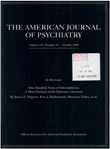The DSM-III-R impulse control disorders not elsewhere classified: clinical characteristics and relationship to other psychiatric disorders
Abstract
OBJECTIVE: The authors reviewed available studies of DSM-III-R impulse control disorders not elsewhere classified in order to determine the relationship of these disorders to one another and to other psychiatric disorders. METHOD: The review focused on the demographic and clinical characteristics, phenomenology, family history, biology, and response to treatment of individuals with intermittent explosive disorder, kleptomania, pathological gambling, pyromania, and trichotillomania. Analysis was restricted to reports which either indicated use of operational diagnostic criteria or provided descriptions of the impulsive behavior detailed enough that patients could be judged as probably meeting the DSM-III-R criteria. RESULTS: Although different impulse control disorders have different sex ratios, all have similar ages at onset and courses. Studies on phenomenology, family history, and response to treatment suggest that intermittent explosive disorder, kleptomania, pathological gambling, pyromania, and trichotillomania may be related to mood disorders, alcohol and psychoactive substance abuse, and anxiety disorders (especially obsessive-compulsive disorder). Biological studies indicate that intermittent explosive disorder and pyromania may share serotonergic abnormalities similar to those reported in mood disorders. CONCLUSIONS: The impulse control disorders not elsewhere classified appear to be related to one another and to mood, anxiety, and psychoactive substance use disorders. Thus, like major depression, obsessive-compulsive disorder, panic disorder, bulimia nervosa, and attention deficit hyperactivity disorder, they may represent forms of "affective spectrum disorder."
Access content
To read the fulltext, please use one of the options below to sign in or purchase access.- Personal login
- Institutional Login
- Sign in via OpenAthens
- Register for access
-
Please login/register if you wish to pair your device and check access availability.
Not a subscriber?
PsychiatryOnline subscription options offer access to the DSM-5 library, books, journals, CME, and patient resources. This all-in-one virtual library provides psychiatrists and mental health professionals with key resources for diagnosis, treatment, research, and professional development.
Need more help? PsychiatryOnline Customer Service may be reached by emailing [email protected] or by calling 800-368-5777 (in the U.S.) or 703-907-7322 (outside the U.S.).



